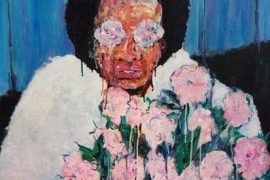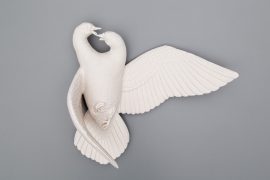Rosarium (Acre Books, 2018) by Hannah Dow
“What Is the Body,” the first poem in Hannah Dow’s debut Rosarium, both asks and suggests: if not a nest— indiscernible like a plover’s shallow hole in sand lined with shell, untouchable like a woodpecker’s mine in a tree’s soft patch. “What Is the Body” defines the idea of the body by way of negation—as “indiscernible” and “untouchable.” In doing so, the poem asks Dow’s reader to think of the negative, the hole (and its homophone “whole”) created by the image of a nest or a woodpecker’s “mine”—a word whose sonics and multiple meanings strikingly reach into the hollow of possession. But more than a meditation on absence itself, the poem asks its reader to think around absence and to compare the body to, If not a verb, a being, the way a pregnant woman who arranges her home is said to be nesting. The pregnant woman images and embodies desire: a longed-for physical presence felt as absence. Though the image in the poem is gendered and maternal, the aching and the waiting are not. Yet, through its listing, the poem’s examples prohibit the reader from floating away into the conceptual, abstract ether, instead anchoring its wonder in a tactile collection (and collecting) of nouns, observing of the body: “How it gathers / everything to itself— / history, windows, warmth.” The negative definitions of the body in Rosarium’s first poem invite the reader to imagine also the soul—a concept often spoken of as indiscernible, untouchable, gathering “everything to itself.” History, feeling and longing offer Dow’s reader a bridge across abstraction and duality. Against the philosophical opposition of body/soul, Ludwig Wittgenstein wrote, “The human body is the best picture of the human soul,” a description that allows the reader to think of the soul as expressed by the very surface and gestures of the body. Simone Weil links the physical and the spiritual in a related way, observing, “All the natural movements of the soul are controlled by laws analogous to those of physical gravity. Grace is the only exception.” Dow’s poem “What Is the Body” is similarly interested in theology and philosophy—a conceptual presence in poetry we often call “metaphysical” as a craft and subject shorthand. But the poem is also “metaphysical” in the technical (philosophical, theological) sense, as: the study of being as being. “If not a verb, a being,” recommends the poem, closing on a leap of images: If not a hive, the bee’s boundless enter and egress, then a mountain thought to be a mountain: what the magma won’t miss when it finally erupts. Now the reader is lifted to the mystical-physical heights of meditation—from the parable-like presence of the bee’s “boundless / enter and egress” to the image of the “mountain / thought to be a mountain.” When is a mountain, great and massive geological presence that it is, not a mountain—when does our vision betray us? When it is a volcano—“what the magma won’t miss / when it finally erupts.” Dow uses the most concrete of images, rock and erupting magma, to unsettle her reader’s preconceptions of knowability. Some things are hidden: bees in their dark hive, magma in the mountain. If the poem delivers a final answer to the question posed by its title, “What Is the Body,” it is the suggestive final lines, “what the magma won’t miss / when it finally erupts.” The poem uses these lines to open up the epistemological and imagistic slippage occurring in the way we think about the human body as something knowable, delineated. The poem’s end, winnowed down to a negative/positive image held tightly together in coupleted opposition, satisfies the way a waterfall or a mountain satisfies—through sublimely filling our vision, through complete and total wonder. What is illuminated is how little we know about any one thing—about the enter and egress of a single bee. Rosarium returns frequently to ideas of the negative and not-knowing, moving through the same conceptual waters as the apophatic/negative theology of Saint Thomas Aquinas or the via negativa of Saint John of the Cross (see Frank Bidart’s translation of “Dark Night of the Soul”), also John Keats’ notion of negative capability, in which a reader “is capable of being in uncertainties, Mysteries, doubts, without any irritable reaching after fact & reason.” Yet Rosarium also mimics the body-as-nest, gathering its many supple narratives like flowers in a garden or the rosary’s sacred beads (the Latin title translates to both rose garden and rosary) and demonstrating a deep preoccupation with natural objects and the physical, natural world. Special poetic forms repeated (a liturgical move) throughout Rosarium include its “postcard” poems from different geographies, “Variation” poems on speech acts (e.g. “Variations on Thank You,” “Variations on Goodbye,” “Variations on I’m Sorry”), apostrophic “Our lady” poems (“Our Lady of the Jail” and “Our Lady of Arts & Crafts”) and multiple mythic “origin” poems. There is a thread of literary inheritance linking Rosarium to the emotional-materialism of the Romanticist poets, specifically through the journals of Dorothy Wordsworth. In a recent conversation with the poet Danielle Deulen, Hannah Dow notes, “I feel a great kinship with Dorothy Wordsworth and many of the Romantic poets. I’m not sure if this allegiance is aesthetic, but I spent a lot of time studying these writers…I was especially drawn to the way Dorothy Wordsworth’s journals insist on the importance of belonging to the environment. Her journals are striking and honest and literary in their own right, and there are now many recuperative efforts to teach her work as literature, not just as ephemera or notes to, in her words, “give Wm. pleasure.”¹ Several prominent themes from Rosarium appear in the above quotation: ecology and ethics (as belonging to and, by implication, owing something to the environment), the labor (emotional, physical, economic and intellectual) of women (often considered gratis on the part of women), and the idea of the archive and canon—what we teach and to whom we teach it. For example, in the poem, “Halcyon: An Origin Story,” we are told (an oral/aural form of teaching) how, “After making precise measurements, / a woman travels to the middle of the ocean // to dissemble her ship.” The woman’s initial “precise measurements” inform everything that happens at sea: the tearing down of the sail, the mast struck “from the bottom // as though cutting down a tree.” The woman alters her environment irrevocably, the language that of deforestation: “the hull, she uproots piece by piece.” But what becomes—an existential term relevant to all the poems in Rosarium—of the destruction is an act of remaking and re-formation, the hull fragments, “leap / like fish finding water, bob, bob and float.” Not a drowning woman but a bird-woman rises from the deconstructed ship and we learn how, “Nothing left to stand on, she knots the sail / around her shoulders and, with the pieces, / / draws together her nest.” In Dow’s retelling of the myth of Alcyone of Trachis, the woman still becomes the bird—perhaps she still loses her husband to shipwreck and drowning. But the revision is that, in this version, Alcyone plans her nesting and makes calculations towards her metamorphosis to Halcyon, or the kingfisher. We do not learn if this Alcyone is grieving, but we do learn that she is a mathematician of her transformation at sea, that she is a builder and a provider for herself. Nature also bends towards the poems’ speakers in Rosarium, offering an eco-poetic mode of understanding—as in “Genealogy,” where we are told: this tree vines itself to another like an umbilical cord like the midwife or its father forgot to cut it from its mother In the scope of “Genealogy,” the environment and natural world of the speaker is just that—a genealogy, a family of relationships. “What if we were all still joined,” the final line wonders, echoing Dow’s appreciation of Dorothy Wordsworth’s journals insistence on “belonging to the environment.” Being in communion with the objects and presences, feelings and absences of the environment is a relationship that is second nature to the speaker in many of Rosarium’s poems. If in “Genealogy,” the physical bodies of the trees and the speaker are entwined mystically through metaphor, in “Postcard from Los Angeles, California,” the sacred manifests as physical stigmata on the speaker’s body (“I looked down / at my palms, saw roses, winced // at the open close of their tender blooming”). In “Not My Day,” the speaker finds herself, “at another wedding / not my own,” and addresses the crucifix of Christ, observing, “no one but me // notices him or the way / his muscles thrust / in chiseled pain.” One of Rosarium’s most erotic poems, “Liturgy,” collages the language of the sacrament of communion into a heated scene of “the overturned chair / slow-burning flame.” Rosarium brims with the human body, the ecological body, the spiritual body. These unplumbable poems, filled with myth and the sacred and partaking in the everyday “forms of life” (Wittgenstein again), will have you returning again and again. As the consoling speaker in “A Dream of Burial Means to Acknowledge Something in Your Life is Ending” affirms of humans: “We are not deer, / stumbling into light, but we / chase, and we chase, and we chase.” ___________________________- Emphasis added.





